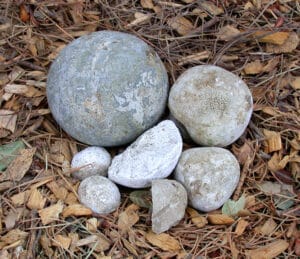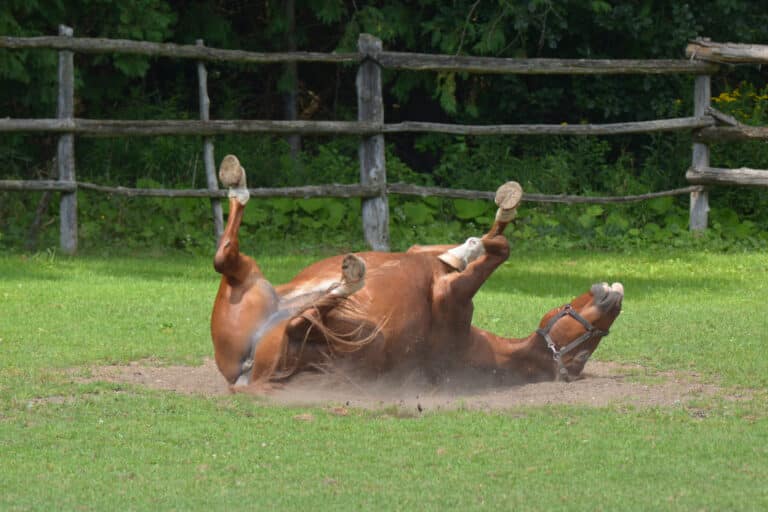Colic is a common and potentially serious condition which can affect horses of all ages and breeds. RACHEL ROAN spoke with Dr. Caroline Spelta to find out more.
Signs of colic are usually easy to detect. Depending on the severity and cause, they can include restlessness, pawing, kicking at the belly, rolling or attempting to roll, sweating, appetite loss, decreased or the absence of defecation, and an elevated heart rate. “Some horses will stretch out as if they want to pee, others will lie out flat, or stay lying down when they usually wouldn’t,” Caroline explains, “and in more severe cases you often see them drop suddenly to roll.”
It’s a mistake to believe rolling can cause a horse’s gut to twist. The rolling is actually a symptom of gut pain, rather than the cause. “A horse can’t lie down for a roll in the sand and get up with colic. The pain is already there,” says Caroline. “It’s bad for them to roll due to the risk of hurting themselves. They can often sustain an injury when throwing themselves down, take skin off, get cast, or become stuck under a fence or rail.” Walking a colicking horse provides a very low level of pain relief and is useful in preventing rolling while you wait for your vet.
The word ‘colic’ means abdominal pain, so narrowing down its cause can prove challenging. “For example, a stallion showing signs of colic could actually have a twisted testicle,” says Caroline. Changes in diet or the weather, such as a series of cold days where a horse drinks less, can increase the risk of impaction colic, while a horse at the bottom of the herd pecking order may also be at increased risk. “When the others go for a drink, the one at the bottom will sit at the round bale, eating as much as possible while they’re gone, often forgoing a drink,” she adds. Sand colic is frequent where there is short, fresh, green grass. While trying to consume short feed the horse may ingest sand or dirt, which accumulates in their digestive system causing inflammation and irritation.

In any suspected colic case, call your vet straight away to prevent a decline in your horse’s wellbeing. “A vet will listen to the horse’s heart rate and their gut sounds, and depending on the facilities available, will do an abdominal palpation per rectum,” Caroline explains. “Depending on the horse’s history, along with what they feel and see, some vets then do an ultrasound to get a better idea of the cause so they can form the best treatment plan.”
Treatments vary depending on cause and severity. For mild cases, medication such as pain relievers and laxatives might do the trick, while severe cases may require surgery. A horse with impaction colic would be treated with fluids and pain relief administered intravenously or by nasogastric intubation, whereas spasmodic colic (often the result of eating a noxious weed) causes the horse to cramp up, requiring pain relief but not fluids as dehydration is not a contributing factor. Surgery may be required in cases of a twisted or displaced bowl, or severe impactions.
Deciding to operate requires careful consideration, and a vet will weigh up the horse’s overall health, severity of the colic, the risks and potential complications. “If you can’t control them medically and they’re not responding to pain meds, then surgery is an option regardless of the suspected cause,” Caroline says. “If the rectal and ultrasound examinations indicate the horse already has a twisted bowel, surgery is the best approach to put that all back before it becomes further compromised.”
A vet may conduct an abdominocentesis test to assess the health of the bowel. “By putting a needle sterilely into the abdomen to collect the fluid in the intestine, we can determine whether the bowel is still alive or not,” Caroline explains. “If the bowel is dead or dying and surgery is not an option, unfortunately that horse will not survive.”
Not all veterinary clinics are equipped to perform colic surgery, which requires specialised surgical facilities and skills. “The horse is put on their back, and the surgeon will make a midline incision. The type of surgery will dictate the length of the incision, depending on whether it’s the small or large intestine. Certain types require bigger incisions to enable access.”
Colic surgery is often a last resort when other treatments have failed, and horse owners need to consider the financial cost, which may include a lengthy post-op recovery time, and the possibility of complications.
As with most things, colic prevention is better than a cure, and owners can take a range of measures to reduce the risk: poor quality hay should be soaked in water to remove any particles that may irritate the digestive system; slow feeders or nets help reduce impaction by preventing horses from hoovering their food; and feeding on a large rubber mat or concrete pad can prevent the intake of sand and dirt. Caroline suggests regularly adding psyllium to your horse’s feed to help remove sand from their system, as well as keeping their teeth in good order so they can chew properly (thus reducing the risk of impaction colic), and adding salt to their diet to encourage them to drink.
Worming horses with a large worm burden can also cause colic. “Small strongyles have an encysted larval stage, where the larvae go in and make little cysts inside the bowel wall,” Caroline explains. “If a horse hasn’t been wormed in a long time and you give them a very effective wormer that kills the larvae in one hit, they will actually come out of the gut wall, essentially putting a million little ulcers in that wall.”
Foals with roundworms also present a colic risk. “Killing a large burden of roundworms can cause an impaction as they get tangled into a knot of dead worms. So when there are large worm burdens it’s killing the worms that’s the issue, not the worms themselves,” she adds. To avoid these situations, faecal egg counts are top of the list, as is ensuring the right wormer is used, and that worming is done when the horse needs it, rather than on a six weekly schedule which only contributes to the problem of worm resistance.
Enteroliths (mineral concretions that form in horses’ intestines) are a common culprit in chronic colic cases. They can range in size from small pebbles to large rocks and form around a nidas – a foreign object such as a grain of sand, piece of bailing twine, or a small rock that the horse has ingested. “Minerals from the diet bind to the nidas, growing bigger in layers.

When you cut them in half, they often look like an onion,” Caroline explains. “They eventually grow large enough so that as they travel through the intestine, they can sit and block it like a one-way ball valve. This causes an impaction colic as the enterolith has blocked the pathway out, causing distension behind it.”

Enterolith colic cases are challenging because they reoccur. “You relax the gut which allows the rock to roll back out of the channel and the block goes away, but six months later it might have rolled back into the bend of the intestine, causing another blockage,” Caroline says, noting that some enteroliths can become as big as a rockmelon. They will eventually kill the horse if untreated, but once formed, surgery is the only option to remove them. “Unfortunately, we can’t break them down,” she says, “but you can feed apple cider vinegar to stop them from occurring, which is recommended if you’re in a high mineral content country.”



